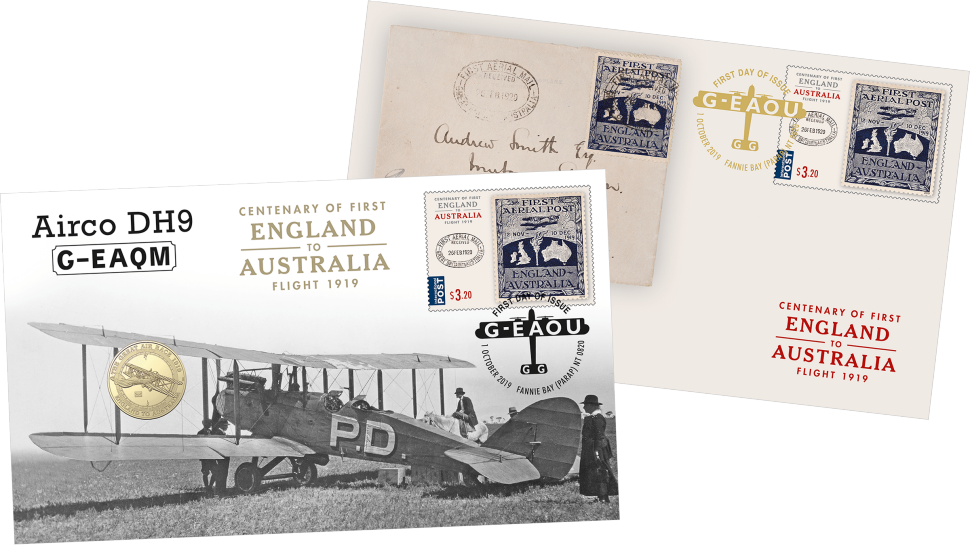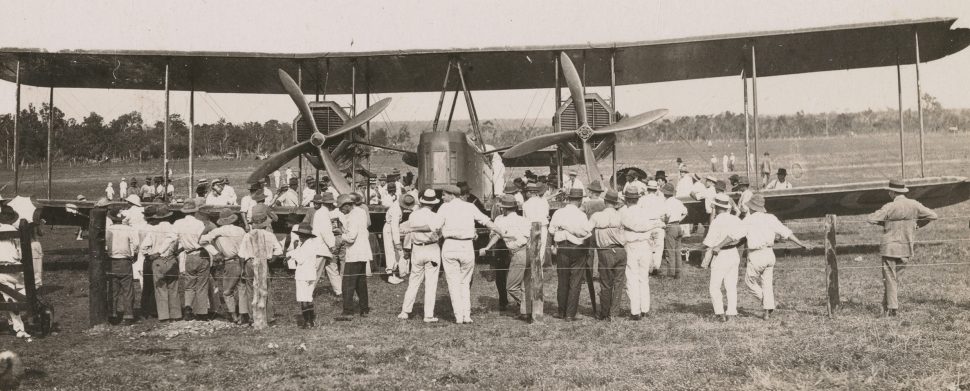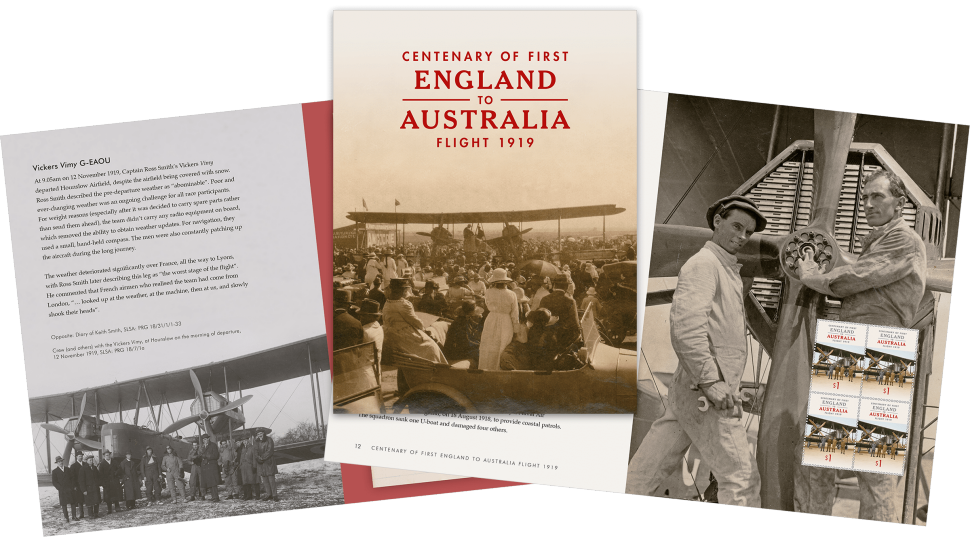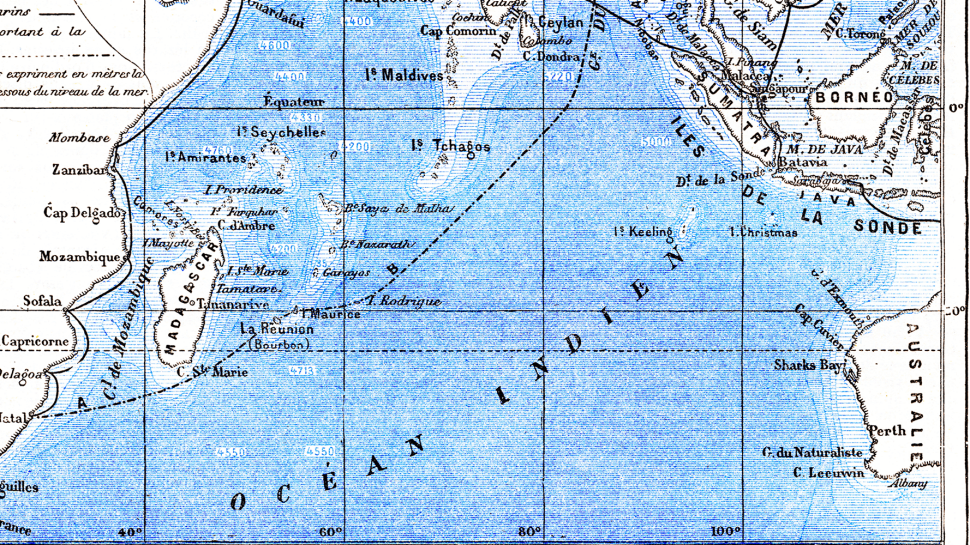When Captain Ross Smith and crew successfully landed their Vickers Vimy twin-engine bi-plane at Fannie Bay airfield, Darwin, on 10 December 1919, the event was rightly met with national and international acclaim. This was the first flight from England to Australia – an incredible, record-setting distance of almost 17,800 kilometres (11,060 miles), at a time when the greatest distance flown was just over 5,000 kilometres in 1918.
Adelaide-born Ross Smith was accompanied by his brother Lieutenant Keith Smith, as navigator and co-pilot, and by mechanics Sergeants Walter Shiers, also from Adelaide, and James Bennett, from Victoria. The flight also carried the first overseas airmail to Australia.
Only two of the six Australian planes attempting the journey made it to Australia, the Vickers Vimy G-EAOU and the Airco DH9 G-EAQM, the latter plane departing London after the Vimy had already arrived in Australia. However, as the Lieutenants Ray Parer and John McIntosh faced the prospect of flying the first single-engine plane from England to Australia, they decided to proceed anyway. They received a £500 consolation prize, despite being well over the 30-day time limit under the race rules.
Veteran aviator Etienne Poulet from France, ineligible for the prize money as he wasn’t Australian, made it as far as Java, Indonesia. Sadly, four aviators perished during their attempt: Lieutenants Roger Douglas and James Ross, flying Alliance P-2 Endeavour G-EAOX, and Captain Cedric Howell and air mechanic George Fraser, flying Martinsyde A Mk 1 G-EAMR. An inquest was held into Howell’s death, amidst claims of sabotage.
In early 1920, the Smith brothers were knighted for their efforts; Shiers and Bennett received the new Air Force Medal bar and became honorary lieutenants. Ross Smith was tragically killed in a flying accident in 1922 and was given a state funeral. In November this year, Shiers and Bennett will join Sir Ross and Sir Keith Smith as inductees into the Australian Aviation Hall of Fame.
The epic flight and the first overseas airmail are commemorated in the Centenary of First England to Australia Flight stamp issue, which will be released on 1 October 2019. The stamps, by Janet Boschen Design, include a domestic-rate and international-rate design.
A prestige booklet has been released with this issue, delving further into this fascinating story, including a summary of the journey taken by each of the six Australian crews that attempted the flight, as well as information about the far-reaching impacts of this amazing flight. The booklet includes many wonderful photographs from the substantial collection housed in the State Library of South Australia.
A prestige cover includes a reproduction of a letter from Ross Smith to his parents, Andrew and Jessie Smith of Adelaide, penned before his departure from England and carried on board the historic flight. A medallion cover and three postal numismatic covers (PNCs) have also been released, including a PNC recognising the efforts of the pilots of the Airco DH9.

Of great assistance to Australia Post Philatelic researcher Jane Levin were several experts: Paul Ewoldt, President of the Aviation Historical Society of Australia (NSW) Inc.; Gareth Morgan, President of the Australian Society of WWI Aero Historians; and journalist and author Lainie Anderson, who has recently released a book on the topic, Long Flight Home (Wakefield Press, 2019). Martin Walker, member of the Australian Air Mail Society and President of the Aeropex Organising Committee, kindly provided items from his collection for use on the international-rate stamp and on various products. Aeropex 2019, which is being held between 6 and 8 December 2019 in Adelaide, focuses on the flight centenary.
Paul Ewoldt became interested in aviation in the 1960s, following on from an interest in building model aeroplanes. In the same decade, in 1965, the Aviation Historical Society of Australia (NSW) was established, with the aim of bringing together like-minded people with an interest in aviation. Paul became President three years ago, and the membership will play a supporting role in the planned centenary re-enactment flights, by providing research assistance and support.
“The Ross and Keith Smith flight of 1919 was the first major milestone in Australian aviation history. It proved that long-distance flying could be achieved between the two countries and thus paved the way for others. The Australian nation was shaped enormously by this great leap forward in transport and communications, which connected the nation to the outside world for future generations to come,” says Paul.
Gareth Morgan worked in aviation-related Commonwealth Government Departments for over 35 years, specialising in aviation security for much of that time. Prior to retirement, Gareth was Manager of the NSW Region of the Department of Transport and Regional Services, responsible for the oversight of security procedures by airlines and airports in NSW and Norfolk Island.
“Reading ‘Biggles’ books in childhood sparked an interest in aviation during the Great War, an interest that has stayed with me for some sixty years,” says Gareth.
“In 1919, after four years of war, the military use of aeroplanes was then well established. The England-Australia flight by the Vimy was probably the most significant aviation achievement of 1919, as – like the crossing of the Atlantic and the flight from the UK to South Africa, also using Vimys – it did so much to prove to a war-weary world the potential of civil aircraft to fly long distances with a degree of safety,” notes Gareth.
Lainie Anderson has been a weekly columnist with Adelaide’s Sunday Mail since 2007, and previously worked at the Herald Sun in Melbourne and the Times in London. In 2017, Lainie travelled to nine countries on a Churchill Fellowship to gauge the significance of the pioneering 1919 flight from England to Australia and the Vickers Vimy aircraft, which is now housed at Adelaide Airport. Lainie is also South Australia’s Epic Flight Centenary 2019 program ambassador.
“My interest in the flight and the Vickers Vimy began in 2009, when an old school friend contacted me to suggest I write one of my Sunday Mail columns on the plane that had defied the odds to make it halfway across the world, and was now out of sight at the back of Adelaide Airport. I started researching the plane and discovered it had made the very first flight from England to Australia, and that its pilot Ross Smith was one of Australia’s most decorated airmen of WWI. He was even Lawrence of Arabia’s pilot!” says Lainie.
Lainie was struck by the enormity of the achievement.
“The first flight across the world was achieved just 16 years after the Wright brothers flew for a few seconds. It was achieved in a plane of wood, wire and fabric, with open cockpits and little more than a compass for navigation. It was achieved at a time when airfields beyond India were basically non-existent, by men who were so ingenious that they used chewing gum to fix a broken induction pipe and laid 300 metres of woven bamboo matting to take off over a waterlogged runway. It was an incredible human endeavour – and it’s little wonder the feat was likened at the time to Christopher Columbus discovering the New World,” says Lainie.
Lainie’s first column generated a huge response from readers.
“Sunday Mail readers across South Australia remembered the plane and the pioneering aviators Sir Ross and Sir Keith Smith from their own childhoods and wanted the story to be celebrated as a major feat achieved by South Australians. One thing led to another – someone suggested I write a book, and someone else suggested I apply for a Churchill Fellowship, and I decided to do both,” says Lainie.
The main aim of the fellowship was to gauge the international significance of the flight and the Vickers Vimy – in effect to build a business case for moving the plane to a position of greater prominence at Adelaide Airport.
“At the Smithsonian Air and Space Museum in Washington, Alex Spencer told me the plane is one of the most precious aviation artefacts on the planet – the equivalent of Charles Lindbergh’s Spirit of St Louis. At the National Aerospace Library in London, Brian Riddle told me that in its day, the flight from England to Australia was as awe-inspiring as man landing on the moon 50 years later. It was fantastic,” says Lainie.
“My role, both as a Churchill Fellow and as program ambassador for the Epic Flight Centenary, is to make Australians proud of this incredible aviation feat, and to champion the men who accomplished it – the Smith brothers and their incredible mechanics Wally Shiers and Jim Bennett. Australians can be pretty apathetic when it comes to celebrating our own pioneering achievements, and I think it’s sad that stories like this have been lost to history. We want a new generation of kids to learn this story and be inspired to reach great heights,” says Lainie.
“This centenary year has been a wonderful turning point. The Commonwealth and South Australian governments have both recently committed $2 million to the relocation of the Vickers Vimy into a prominent location within Adelaide’s beautiful new airport terminal. The funding was matched by Adelaide Airport Ltd and we should see the plane moved by 2021,” notes Lainie.
In Lainie’s recently published book, Long Flight Home, she cleverly tells the story of the 1919 flight through the eyes of Wally Shiers, via diary entries and correspondence.
“My aim was to push the story beyond aviation circles, so I decided to write the kind of historic novel that my own book club would want to read. When I discovered that mechanic Wally Shiers had a sweetheart before he went off to war, I knew he was the perfect person to tell the story. Wally’s just an ordinary bloke who took part in an extraordinary adventure. Long Flight Home is historic fiction grounded in fact – a sort of boy’s own adventure for girls – and I’ve been blown away by the response from readers,” says Lainie.
Smith family descendant Gary Lloyd provided valuable perspectives on Australia’s pioneering siblings of aviation to the researcher on this stamp issue. Gary’s maternal grandmother was a first cousin to Ross and Keith Smith – their mothers were sisters, which makes Gary a first cousin twice removed. Growing up, Gary was very aware of the legacy left by his famous relatives.
“We were well aware of their aviation brilliance and the fact that they were Australian aviation heroes. They were often spoken of with a sense of awe and reverence, but as a child I had no real concept of the magnitude of what they had achieved, and the obstacles and risks they faced in both entering and completing it,” says Gary.
“As an adult, and as my interest in family history grew, I read a lot more about them and gained a good understanding of how capable they were and what a really amazing feat they achieved, which has been likened to the feat of man landing on the Moon just 50 years later. It also became obvious that they were not just Australian aviation heroes, but world aviation heroes. Ross Smith in particular was one of the most highly decorated allied pilots in World War I. He had that ideal mixture of capability, confidence, caution, courage, planning ability, education and Aussie larrikinism, such that he could easily mix with the top brass and the lowest ranks,” notes Gary.
“Keith Smith was the oldest brother, by two years, but Ross was always ‘the boss’ and the one who achieved more success up to the point when he was tragically killed. When war was declared in July 1914, Ross was one of the first South Australians to enlist (in August 1914) and joined the Australian 3rd Light Horse. He told Keith that he should stay home and look after their mother!” says Gary.
“When Keith died in 1955, his wife, Lady Anita, inherited his estate. When Lady Anita died in 1986 she bequeathed her entire estate to the establishment of the Sir Ross & Sir Keith Smith fund, and directed that the income of the Fund be applied in perpetuity for ‘advancement in the State of South Australia of the science of aeronautics and of education therein’. To date, grants, scholarships and sponsorships in excess of $7 million have been made.”
Gary is also a member of Epic Flight Centenary Committee, representing the Smith family. The committee is helping plan many events in Adelaide this year to promote the epic flight and the legacy of the Smith brothers.
Gary feels that there are many aspects of this legacy that may not be obvious to many people.
For example, on a broader scale, the flight was the inspiration for the founding of Qantas in November 1920 (and the runways built as part of the pre-flight survey formed part of the network that Qantas used). Keith Smith even later became a director of Qantas, as part of a successful business career in aviation. On a more personal level, the flight was a source of inspiration for Australia’s first astronaut.
“As a child, Adelaide-born Andy Thomas used to visit the Vickers Vimy aeroplane at Adelaide Airport, and the inspiration he got from the epic flight was one of the catalysts for him to go into the aviation industry and ultimately become Australia’s first astronaut, flying four missions in to space. On one of those missions in to space, Andy took the Air Force wings belonging to Ross and Keith,” says Gary.
“I am very proud and pleased that this stamp issue is being released and bestowing a well-deserved honour. It is another way that Australians can learn about the epic flight, the Vickers Vimy and the crew members. Stamps are a great way to give this story extensive coverage and will hopefully encourage people to wonder about and investigate the significance of the story behind the stamps,” says Gary.
“As Australians, we should be aware and proud of our high achievers and heroes, and celebrate their success, and this includes the Smith brothers and their two mechanics. I hope that the extensive calendar of events organised to take place in this centenary year may be an inspiration to the younger generation to pursue their dreams and realise that great things can be achieved by seemingly ordinary people,” says Gary.
Lainie, too, is excited about the upcoming stamp release.
“I am absolutely thrilled the stamps are being issued, because they will raise awareness about the achievement right across Australia. It’s particularly special given the Vimy delivered the very first international airmail into Australia,” says Lainie.
“I reckon the Smith crew would be really chuffed!”
The Centenary of First England to Australia Flight stamp issue is available from 1 October 2019, online, at participating Post Offices and via mail order on 1800 331 794, while stocks last.
View the gallery and technical details from this issue
Read about the first overseas airmail to Australia
This content was produced at the time of the stamp issue release date and will not be updated.






